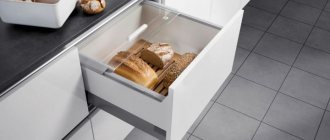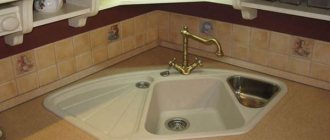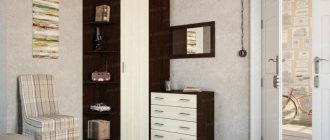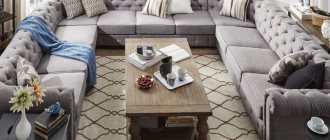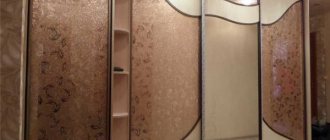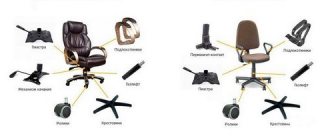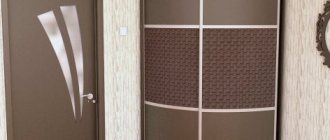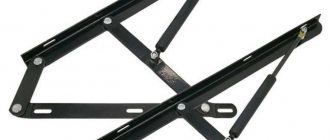The layout of kitchen furniture requires special attention, especially in old-style apartments, where extremely rational use of free space is necessary for a comfortable stay. One of the options for a compact and ergonomic kitchen arrangement would be to install a corner set. This furniture consists of two modules located along the walls, the space between which is filled by a corner cabinet under the sink. Its design, varieties, sizes and assembly methods will be discussed later in this article.
Example of a corner cabinet for a kitchen sink
Design Features
High-quality sink cabinets are a great necessity in every home. The purchase of these products must be thoughtful and balanced, because for the kitchen you need to select furniture that is optimal in size. It is also important to purchase products based on their aesthetic and decorative features.
This workplace should be very comfortable and preferably multifunctional, since the corner is a fairly large space.
When choosing, you need to consider what functions this bedside table performs:
- The practical side. Rationalization of the square footage in the room - the object takes up a minimum of free space, in addition, it houses other household appliances: a cabinet, a sink, communications, etc.
- A corner cabinet connects the kitchen unit along the walls.
- Expressiveness and aesthetics. If all the elements of the room’s style, including the sink-bedside table, are correctly selected, the kitchen will look quite representative.
- Aspect of comfortable use. If you plan the purchase and installation of the cabinet correctly, it will always be quite convenient for the housewife to use the cabinet while cooking.
A corner kitchen set is a necessary necessity: the size of the kitchen is not large enough to place everything you need along one wall.
Important. If a person wishes, he can construct the necessary sample himself, which will meet his purely personal needs.
Varieties
If a product is in demand, it will always have many variations. Let's look at the most popular products:
- Classic L-shape. It is suitable for small spaces, so it fits into the area of most apartments of the post-Soviet period. Schematically, everything is extremely simple - the bedside table with the sink is connected by a kitchen unit, which is located in the shape of the letter “L”.
- Furniture in the shape of the letter "P". Schematically, it may be similar to the L-arrangement. It’s just that now the set is longer, the furniture runs in straight lines along the entire perimeter of the kitchen, near the walls.
- Trapezoid bedside table. Quite a functional option, which entails a higher cost compared to previous products.
- Sink with beveled corners. Interesting design idea. Looks great and modern in a modern kitchen.
Note. Sink cabinets can also be classified according to the material they are made of. For example, from wood, possibly from rare species, or a cheaper and more practical option - from chipboards or wood-fiber material.
Types of corner tables for sinks
There are two main types - rectangular and trapezoidal. They can differ from each other in appearance, design, type of sink (number of sinks, material of manufacture, installation method) and ease of use.
- Rectangular models. Externally, it is a floor cabinet, the side edges of which are adjacent to wall modules. The pairing of the side elements occurs at an angle repeating the junction of the walls (90°). The most common and easy to manufacture option, however, it is somewhat deprived of internal space, which affects functionality and is not always convenient to use. Access to the internal contents is possible either through one (the opposite side is made blind in this case) or through two adjacent doors. If there is only one door, it becomes difficult to access objects located in the adjacent part, but if there are two of them, then it will not be possible to open both at once in a normal way. One of the most successful solutions in such cases is to install a double door. In fact, these are the same two doors, only connected to each other by canopies.
It is better to make double doors in a classic corner wardrobe - Trapezoidal wardrobe . A large pentagonal-shaped cabinet, the front part of which has a beveled edge that overlaps the rectangular junction of the side modules. Such solutions are characterized by greater capacity and provide convenient access to the internal contents. However, trapezoidal washing tables are more expensive, take up more space and look somewhat cumbersome in small kitchens. In addition, convenient access is only possible to objects located in close proximity to the front of the bedside table. It is very difficult to get to its far corners through a 45 cm wide door.
Either a mortise or overhead sink with one or two sinks and additional space for drying dishes can be installed on top of the base. The most common material used for manufacturing is stainless steel. Nowadays, mortise metal models are available and popular; they are quite spacious, strong and durable. Overhead stainless steel options are used extremely rarely, which cannot be said about monolithic solutions made of artificial stone.
Tips for choosing
Interior design is a delicate matter. Every housewife dreams of arranging her living space, while choosing the right furniture to match the interior of the room itself. As for the kitchen cabinet, it should also be functional, in addition to aesthetic aspects. How to choose the right product?
The corner cabinet under the sink plays a connecting function between the cabinets on two walls.
To do this, you must follow the following recommendations:
- The design of the room, as a rule, will tell you which sink you should purchase. Of course, choose options that will fit into the style of a separate room or the entire apartment.
- Another important factor in the choice is the material from which the products are made. Always give your vote to eco-friendly products.
- You should pay attention to reliability and practicality, reviews for specific models. Find out how durable a pressure washer is.
- To what extent does this design suit the owners? The psychological factor plays a huge role. The most trendy products will not be desirable if the consumer had prejudices towards them from the very beginning.
A corner kitchen cabinet is much larger than its straight counterparts and, accordingly, will accommodate a larger number of kitchen utensils.
Additional Information. The sink cabinet should concentrate two main features: beauty and functionality.
How to make a corner cabinet yourself
The kitchen is probably the favorite place to spend time for both adults and children. It’s so nice to have dinner with your family, gossip or just sit with a cup of coffee. Therefore, everything on it should be perfect (in the opinion of specific owners). If you cannot find a suitable design, it can be made. This is also possible with a sink cabinet.
This place is almost always used for installing a sink, which means that a siphon, pipes, and technical communications will be hidden in the cabinet.
First of all, you need to decide:
- what type of product needs to be invented, its dimensions;
- view and familiarize yourself with information on this issue, be sure to study photo and video materials;
- calculate estimates for materials, tools, etc.
Important! In most cases, making it yourself is much cheaper than buying it in a store.
If the preparatory stage is completed, you can begin the actual work. It’s better to start with the classic version, simpler, but also the most popular - L-shaped.
In stores you can most often buy a kitchen set with an L-shaped corner sink or with a trapezoidal cabinet under the sink.
Drawing and dimensions
The initial stage of work is to decide on the size of the corner cabinet for the kitchen sink. To do this, you first need to take appropriate measurements of the room and draw a diagram of the project.
The back part for a trapezoidal bedside table is formed according to the same principle as for a rectangular one, otherwise the schematic drawing looks like this.
In the drawing, it is necessary to take into account communications at the site, whether other elements of furniture or equipment will be located near the sink. As a rule, the drawing can first be made on a simple squared piece of paper from a notebook. Modern technologies make it possible to subsequently create a three-dimensional project on a computer, etc. The scheme should include:
- View of the structure from all angles. From the side, from above.
- It is imperative to detail the drawing, down to the smallest samples. If this is a classic, then highlight the dimensions of the right and left cabinets (which are located near the sink), indicate the horizontal connection of these objects (front side) and all subsequent connecting strips.
- Clearly design parts of the frame, walls, back and floor coverings, facade, etc.
- It is necessary to thoroughly consider the placement of shelves and doors.
The drawing with one blank wall is relevant when supplying communications from the side.
The entire kitchen layout must fit into the overall interior of the kitchen unit.
Selection of tools and materials
Let's dwell on the materials from which it is possible to make a good bedside table. First, pay attention to the old furniture; some parts can be used to build a good sink. If you start work from scratch, you will need chipboard or MDF, as well as plywood. The entire product can be made exclusively from wood; sometimes folk craftsmen design excellent wooden objects, and even in a single copy.
A popular material for inexpensive furniture. The service life will largely depend on the finishing method.
Of the tools that are needed for the project, most are available from good owners, and if not, then you will have to purchase it, which will be a good investment for the future - the ability to produce similar crafts at any time. The necessary accessories and tools are as follows:
- roulette;
- pencil;
- hacksaw;
- screw tie;
- screwdrivers are different;
- priming;
- protective devices;
- cutter;
- drill;
- screwdriver;
- level;
- plane;
- jigsaw;
- nails, screws and self-tapping screws;
- hinges, handles, etc.
A good craftsman knows how to replace a tool he doesn’t have, or how to do without it.
Assembling the cabinet
Before starting the main work, you need to prepare the walls that will be behind the sink. They should be even. If the owners wish, they are covered with wallpaper or treated with appropriate materials. Start of assembly:
- divide all materials according to the drawing;
- varnish the surface of the samples;
- we fasten the fittings, check the façade parts (how well they correspond to the design);
- we assemble the main countertop, mark where the sink and cabinets will be located, and make the corresponding holes;
- we install upper and lower cabinets;
- We install the tabletop canvas.
All that remains is to screw the countertop, cut in the sink, put the structure in place and connect it to the sides of the set.
This is only a complex process at first glance, but if you plan your actions, a person with minimal knowledge of carpentry can build good furniture.
A large pentagonal-shaped cabinet, the front part of which has a beveled edge that overlaps the rectangular junction of the side modules.
Final stage
The final touch is the assembly of the facade parts, which must be done in advance and tried on during the installation of the main part. The doors are attached to pre-installed hinges. If necessary, handles are fixed (if they were not installed immediately).
Such solutions are characterized by greater capacity and provide convenient access to the internal contents.
Façade details are the part of the structure that will be most exposed. It will also be used quite often by all family members. Therefore, you need to select high-quality materials.
Either a mortise or overhead sink with one or two sinks and additional space for drying dishes can be installed on top of the base.
Note. It is necessary to do everything according to the previously developed scheme, and there will be no problems in the work. If a craftsman likes his craft, he can continue, the sink will become the starting point in the manufacture of the entire kitchen set.
Drawings of corner cabinets for sinks
If you do not take into account the principle of building in a sink bowl (and it can be overhead or mortise), then there are three designs of a corner cabinet for sinks:
- Straight side corner table. In fact, it is a standard kitchen module with one “muffled” door - a false panel. The most common option in modular kitchens.
- L-shaped corner table-pedestal. The most flexible option in terms of resizing. Most often it is equipped with a transforming door, which significantly expands access to the inside of the cabinet.
- Trapezoidal table-pedestal for sink. The most bulky “classic” version of a corner cabinet for a sink. It is not recommended to install it in small kitchens, as it “eats up” a lot of usable space.
Drawings of a corner table-cabinet for an “added” sink
Typical dimensions of a corner cabinet for a sink of this design are 1000x600 mm along the countertop. At the same time, the module itself, taking into account the overhang of the tabletop in front, behind and from the corner, has dimensions of 950x550. The dimensions of the facade with these dimensions and the standard height of the kitchen modules are 716x396 mm.
Drawings with dimensions for an attached corner sink cabinet
Usually, to supply water supply communications, a cut is made in the inner side of the cabinet under the sink, approximately 250x150.
If the pipes go deeper, then it is better to make the sidewall not solid, but to “assemble” it from planks.
Drawings of an L-shaped corner cabinet for a sink
For a table-cabinet of this design, you can give two drawings, with different designs of the back walls. The first drawing is suitable if all communications “enter” from the corner on one side.
Drawings with dimensions of an L-shaped corner cabinet for a sink
If you plan to install counters in the cabinet under the sink, connect a separate filter, and generally plan a lot of wiring (for a dishwasher, washing machine), then it is better to leave both sides hollow.
Drawings with dimensions of a corner L-shaped cabinet for a sink
The dimensions of the corner sink cabinet in the standard version are 920x920 mm (taking into account the rear overhang of the countertop 970x970 mm). In this case, two doors measuring 716x396 are installed.
The module can be modified by cutting the size of any of the sides. In this case, the wider door is always attached to the side, and the lighter one is attached to it. Otherwise, the transforming door will begin to sag over time.
Drawings of the “trapezoid” sink table
Corner sink cabinets with a characteristic trapezoidal shape look good only in spacious kitchens with a classic design.
Drawings with dimensions of a corner cabinet for a trapezoid sink
For modern kitchen design, the design of the first two variants of cabinet sinks is better suited.
The design is somewhat softened by the radius design of the door and tabletop, with a concave shape.
But at the same time, the kitchen module itself remains very bulky, voluminous, with limited access inside. With its overall dimensions of 900x900 (including tabletop overhangs), the door is 716x470.
Another disadvantage of this kitchen module is that it requires additional joining of standard worktops with a width of 600 mm. And this means the presence of an additional seam in the sink area, which can potentially swell from moisture.
The joint is made at the same level as the sink or through a superstructure.
The joint can be avoided if you order a countertop made of artificial stone or plastic. But this leads to an increase in the cost of the entire kitchen.
There are also pentagonal, ready-made post-formed countertops on sale specifically for trapezoid sinks. But their range is limited.
Where can I put it?
The location of the sink cabinet is a very important aspect in the interior design of the room. You can install this design:
- Near the gas stove. This is the most popular option. Since all the equipment is at hand, cooking happens much faster. But it’s unpleasant when detergent from the sink gets into your food. So, such proximity has its negative aspects.
- Corner or classic placement. This location is the most acceptable saving of square meters in a small space.
- Bedside table by the window. An interesting approach for those who like to see nature or city life from the window while cooking. Don't forget that washing windows will be twice as dirty.
- In the middle of the kitchen (also called an island). In most cases, such a cabinet is also a dining table. Unusual layout, somewhat reminiscent of a restaurant style. Remember that with this design, the water pipes will have to be adjusted to the sink.
Dimensions of corner floor cabinets
The standard dimensions of a corner washing table are 90 cm for each side adjacent to the wall, that is, 90x90 cm. In this case, the underframe is spacious enough for both rectangular and trapezoidal shapes. The load on the load-bearing elements is distributed evenly, which contributes to a long service life. Dimensions of the remaining parts for the 60 cm tabletop:
- The side walls adjacent to the straight elements of the headset are 50 cm wide, the height depends on the project (in most cases it is 70-90 cm).
- The door width is 40 cm, the height corresponds to the design value.
Larger non-standard version – 98x98 cm:
- Depth of side elements – 51 cm;
- Door width – 47 cm;
The most compact solutions have dimensions of 60x60 cm along the corner walls, while the size of the remaining parts is as follows:
- Depth 30 cm;
- Door width – 40 cm.
With such dimensions of the lower frame, it is only possible to install a full-fledged sink in a trapezoidal structure.
Methods for installing a corner kitchen sink
Most modern people with simple knowledge can install this object:
- we fasten the side parts with the bottom part;
- installation of a corner structure;
- we fasten the connecting components;
- installation of legs (if provided);
- We install doors and handles.
At the location of the washing unit, all communications necessary for its functioning are located.
Additional Information. When purchasing any furniture, a diagram is included, with which installation is quite simple. There are two installation methods: mortise and overhead.
Filling the cabinet under the sink
At the location of the washing unit, all communications necessary for its functioning are located. Because of this, such furniture, as a rule, does not have a blank back wall, such as a closet in the hallway. In ordinary rectangular structures there is enough space to organize a convenient connection for hot and cold water, as well as a sewer drain. If you plan to install filter systems, a grinder and an instantaneous water heater, it is better to pay attention to more spacious trapezoidal models.
Filters and a heater, as a rule, are mounted on the walls, and in trapezoidal structures they can be installed in that very far corner that is not easily accessible. Such access is needed quite rarely and is usually needed by specialists who are accustomed to working in cramped conditions.
In addition to placing communications and washing accessories, the underframe can be used to store kitchen utensils. Retractable lattice baskets and rotating grids (carousel systems) will help to properly organize the space at the base. If you plan to place a built-in container for household waste or a simple trash can under the washbasin, it is better to know in advance its size and the approximate location of other filling elements.
Organization of space inside
How you can organize your interior space:
- Using a basket (mesh). All contents are clearly visible during operation.
- Lockers. You can separate some kitchen utensils and household chemicals on all shelves.
- Pull-out drawers. This is the most practical method for storing dishes.
- Pull-out (regular) trash can (or any container). Basically, consumers use the space under the sink this way.
- Mini pantry. We install small shelves, and we get a pantry for storing food that does not spoil for a long time.
A floor-mounted corner cabinet will help you make better use of your kitchen space, making it functional and cozy.
When choosing a suitable design, the main thing is that the kitchen furniture: be stable along with the sink, hide the main communications on the site, have a spacious cabinet and other characteristic features.
What are the dimensions of corner cabinets for sinks?
Of course, there are standards in kitchen furniture. But now they are becoming more and more flexible, adjusted individually to a specific kitchen project.
For a very long time, the standard height of lower kitchen modules was taken to be 850 mm from the floor. Of course, the adjustable legs allowed for an adjustment of 10-20 mm to level the horizon of the working surface. But now making the bottom row of the kitchen higher and lower not by 10-20 mm, but by the entire 100 mm, specifically to suit your height, is not considered something unusual.
The requirements for the location of household appliances have also become more lenient. Modern built-in ovens, hobs, washing machines and dishwashers have become more “loyal” to their “neighbors”. They do not interfere with each other’s work and do not heat up the furniture.
As for corner kitchen cabinets for sinks, their overall dimensions are clearly tied to two components:
- Providing access inside.
- Correct insertion of the sink bowl.
The door of the corner kitchen sink is responsible for the first.
With its standard width of 400 mm, the cabinets themselves will have the dimensions discussed above.
You can reduce the door width to 300-350 mm, but access will be significantly reduced. Make, for example, an attached module not meter long, but 900 mm (the door will be only 300 mm wide). Decide for yourself whether you agree to this, are you ready to put up with the obvious inconveniences?
The only exception is the second version of the corner cabinet. In it, the dimensions can be reduced down to 870x870 mm; due to the transformable door, access to the inside is maintained.
The second criterion – sink cut-in – determines not only the length, but also the depth of the module. Most built-in sinks are designed to fit into a countertop 600 mm deep. At the same time, the washing platform itself is 480-500 mm.
If you find a built-in sink that is narrower in width, then you can proportionally reduce the depth of the module. At the same time, take into account the size of the front overhang of the tabletop and the space that the baseboard will take up. Which, by the way, “passes” at an angle. This means that there should be enough space behind the sink bowl to install it.
